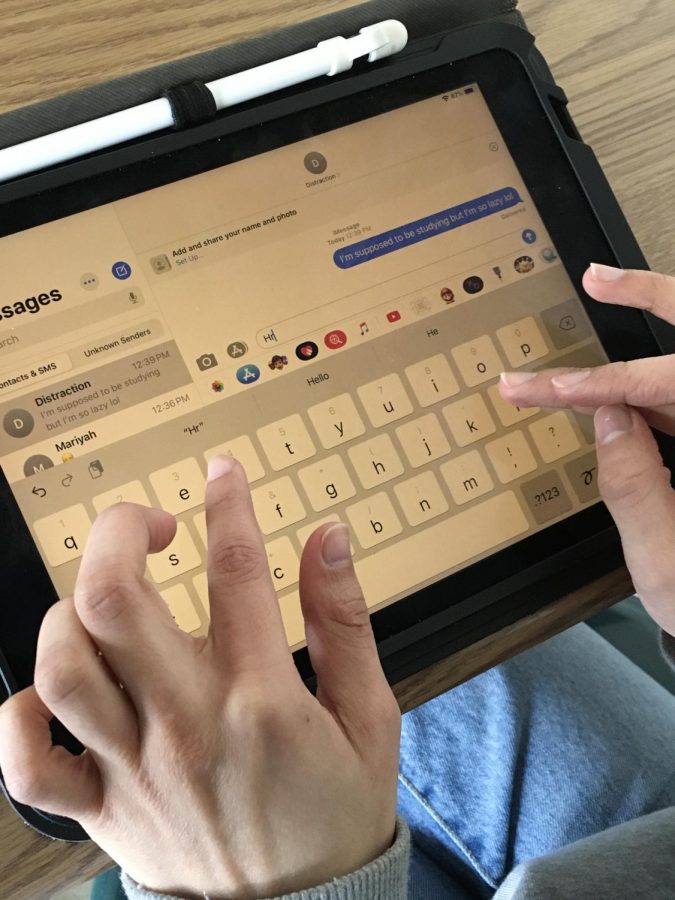A technology-filled classroom poses problems, schools need to find a better balance for students
Are you distracted by other apps while using your iPad during class?
The rise of technology is evident in our society. Individuals of all ages and occupations have found a way to weave technology into their lifestyles or work to promote efficiency in their lives. Currently, according to Statista, 4.33 billion people around the world have access to the Internet.
One of technology’s greatest impacts on society is its implementation in schools. Ed Tech Magazine reports that “about 63 percent of K–12 teachers use technology in the classroom daily.” Technology in classrooms is used in the forms of educational apps or giving students iPads or Chromebooks to use in school or to take home.
While this may seem like the future of learning, integrating technology in classrooms has its downfalls. Having almost unlimited access to the Internet, quick messaging, and games distracts students from learning. Also, continuous use of technology hurts eyesight and disrupts the human body’s natural rhythms. Technology in schools may seem like the future, but it is important to consider the negative effects it has on student learning and health.
Having unrestricted access to the internet and apps distracts students from learning and thereby can have detrimental effects on grades. U.S. News presents a study by the Organization for Economic Cooperation and Development that “looked at computer usage among 15-year-olds across 31 nations and regions, and found that students who used computers more at school had both lower reading and lower math scores, as measured by PISA or Program for International Student Assessment.”
Computer games and messaging is a disturbance in classrooms. It is proven that people cannot multitask, so while a student is playing Cool Math Games, they are missing important lessons presented in class. And these effects are not only impacting the current state of student learning, as if students continuously get low grades, this may diminish their chances to get into a good and competitive college. It could be argued that schools can restrict which sites students can visit or which apps they can download, but the Internet is vast and grand and there will always be away for students to avoid those restrictions and find other ways to be distracted.
An environment with less technology can help students be better learners. The National Pen states that hand writing notes, rather than typing them, leads to better memory recall, sharpens critical thinking, and helps conceptual understanding. All of this contributes to better learning habits and may contribute to better grades. There are skills that technology cannot teach students and that something as simple as pen and paper can.
The direct messaging capabilities on iPads and computers also poses increased chances of cheating, along with being a distraction. The Edvocate reports, “Today’s students use smartphones, tablets or even in-class computers to aid their cheating endeavors and leave no trace of their crimes. Since cheating through technology is not listed specifically as being against the rules in many school policies, students do not view the actions an unethical.” Technology makes cheating quick and easy. From simple homework assignments to test answers, technology is providing students with the ability to cheat in a way that has not been addressed by previous generations.
Further, if schools do not update their policies to inhibit this behavior, then a student’s ability to cheat can be limitless. Schools need to keep up-to-date with technology. Now, students can also cheat using their electronic watches by storing answers there – and not all schools prohibit wearing these watches during tests. It is vital that schools are aware of the newest forms of technology and how students can abuse them for their benefit in schools.
Also, many individuals do not think about the cost of integrating technology into the classroom. The Edvocate interviewed digital CEO Mike Silagadze who said, “Getting iPads, or other mobile devices, into classrooms is just the first step. What many school districts fail to consider when budgeting for the initial purchase is the cost of software, not to mention the teacher training that will be needed to make those devices effective.” Many schools may feel obligated to take a further step into making 21st Century learning possible in their own district. According to Applied Education Systems, 21st Century learning does focus on media and technology literacy – so as schools move to incorporate this learning, it is necessary to figure out a cost effective way to implement computers or iPads into their classrooms.
Since technology is on the rise and is a common aspect in the workplace, schools may feel the need to get their students accustomed to work ethic, but may not have the funds or taxpayer dollars to do so. So, if it is needed for students to learn from various forms of technology to better their work ethic, then it should be a widespread occurrence, so all students have the same ability and resources to get this learning. The only way for this to happen is for the national or state governments to set aside money that is solely for updating the school curriculum to accommodate technological learning.
Also, for teachers who have been teaching for years without the iPad or tablet, it can be difficult to switch over to this entirely new way of teaching. Schools will need to invest time and money to giving teachers lessons about how they can use this technology in classrooms and how to work the system. Yet, even if teachers use these devices, there will still be many teachers who refuse to use these gadgets and hand out physical materials to their students, which is a waste of resources for the school.
Not only does technology in school have social and academic impacts, it also has health effects. According to The Vision Council, “Many individuals suffer from physical eye discomfort after screen use for longer than two hours at a time.” Staring at a screen strains eye-sight and may cause an individual to develop nearsightedness due the proximity a screen usually is to an individual. Furthermore, the University of South Florida reports that “digital eye strain may also affect your head, neck, and shoulders, depending on your posture as you use different devices.” Students usually use their iPads and computers to read their textbook, write their essays, or do research, which most likely means they stare at a screen for prolonged periods of time. This makes students more vulnerable to the negative effects technology has on health. This has long-term effects that may not be seen now, but may grow to become a nuisance for students. Technology is important, but it should not come at the cost of health.
Further, according to Harvard Medical School, “Blue light suppresses melatonin for about twice as long as the green light and shifts circadian rhythms by twice as much.” Melatonin is a hormone that controls the body’s circadian rhythms, which is a 24-hour cycle your body goes through and indicates when to go to sleep and when to wake up. Harvard Medical School also reports that studies have linked light exposure at night to “some types of cancer, diabetes, heart disease, and obesity.” It is a common occurrence that teenagers tend to stay up late and do their homework late at night too, so this light that they are continually exposed to may be detrimental for a student in the future.
Schools can balance technology in classrooms by still providing books and other physical materials so students are not staring at a screen for eight hours. There are ways to find this balance, but school districts need to be active in discovering them.
Yet, having technology in schools is not completely bad. Purdue University states, “Today, massive amounts of information (books, audio, images, videos) are available at one’s fingertips through the Internet, and opportunities for formal learning are available online worldwide through the Khan Academy, MOOCs, podcasts, traditional online degree programs, and more.” Access to the Internet has pushed the boundaries of learning and research for students, but this access comes with a downfall. Students will still distract themselves. The Signal, the newspaper of the College of New Jersey, writes, “Students using their laptops during classroom lectures can be spotted playing computer games, shopping online, browsing through social media, working on assignments for other classes or doing various other activities not relevant to the class.” Being in a classroom setting is not enough. Students will still be willing to browse the Internet than take notes. Students have access to unlimited information, but they also have access to unlimited distractions.
Eliminating technology from the classroom is not very likely. The world today is a technological society, as the Internet is a necessity in this day and age. Social media and phones are being used everywhere -from the workplace to the home settings. Technology will not be disappearing any time soon, but schools must be aware of how technology will impact learning in the classroom and at home, and attempt to find a way technology can be woven into the school curriculum, but still limit the negative effects it poses on student learning and health.
There is a balance, it just needs to be discovered. The future should be pursued, but the past holds important lessons that should not be forgotten. At the end of the day: the pen is mightier than the stylus.

Asiya Mohiuddin is a senior at Glenbard West and has written articles for the newspaper since Freshman year. She mainly enjoys writing Features Articles...








